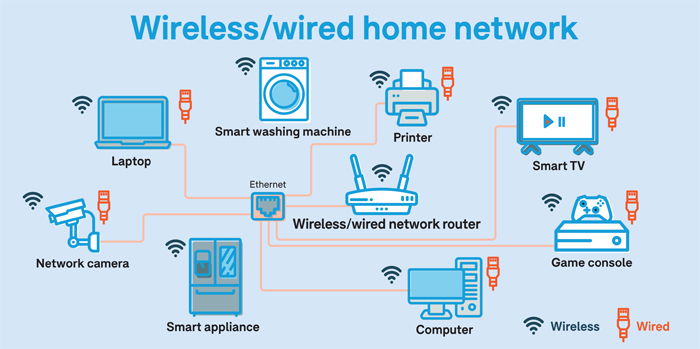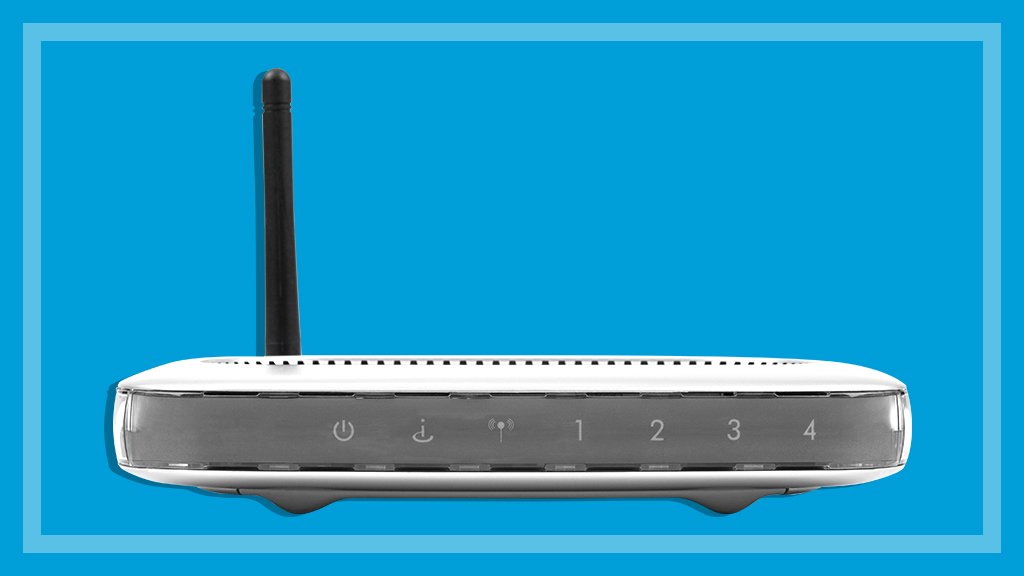Get our independent lab tests, expert reviews and honest advice.
How to set up your home network

It wasn’t that long ago that most of our home entertainment involved listening to the radio, watching free-to-air TV (five channels), or enjoying movies and music on tape and vinyl. Thanks to digital technology, the internet and the ability to create a home network, everything has changed.
On this page:
- Why you should network your home
- How to set up a home network
- How do connect your devices to the network
- What are the different versions of Wi-Fi?
- Do you need a router or switch?
- How to expand your network
- How to link your devices to one another
- How to keep your network secure
Not only are there games consoles for fun and laptops for work, we also want to browse the internet from the comfort of the lounge, stream a movie on our smart TV, and control everything using our smartphone, tablet or voice-controlled smart speaker.
Why you should network your home
This all comes down to ease of access and streamlining control over devices in your house. A fully-networked home opens up three key time-savers.
Media streaming: Your media content could be on your old PC in the study, your smartphone, a network attached storage (NAS) drive or on a USB stick connected to your TV or Blu-ray player, or it could be in the cloud. For example, we can now watch a TV show from a DVD or Blu-ray disc or on a media player or via online streaming services such as iView, Netflix or iTunes. We can view it on an iPad, Android tablet or even a smartphone. A networked home makes it easier to enjoy your content without even thinking about where it came from as it all comes to you over your home network.
Data sharing: Home networks make it much easier to share data between devices such as transferring photos from one computer to another, or wirelessly printing documents in a separate room. You won’t need to worry about USBs or external hard drives.
Home automation: Many new ‘smart’ devices and appliances such as TVs, fridges and lights can be monitored and operated with a smartphone, tablet or smart speaker using voice commands via local and remote networks.
How to set up a home network
The first step to creating a good home network is to identify the ‘WAN’ (wide area network) port on your router, which looks the same as the other ports but is intended only for your NBN modem.
It’s usually labelled and colour-coded differently too so it’s easy to pick out. The other ports are for your wired devices which can generally be attached in any order.
Think about what equipment you want to attach to the network, and where it will be placed in the home in relation to the position of the router. Grab a pencil and paper, and draw up a diagram of your network. That way, you can work out exactly what you need to connect it all.
Working out which networked products will be wired and which will be wireless is important for cabling as well as knowing where there may be any interference for the wireless performance
Working out which networked products will be wired and which will be wireless is important for cabling as well as knowing where there may be any interference for the wireless performance. For example, while you may think placing a wireless printer less than 10 metres from the router will be no problem, it could be a big issue if the wireless signal has to travel through two brick walls.
Writing down all the relevant names and network IDs can also be handy during set-up. The modem, for example, may be constrained by an existing phone port, which is often not in the centre of your home. And it’s a good idea to have the modem and router (and any equipment that will attach directly to the router) together.
If you’re using a lot of wireless products and not many things that need to be plugged in via a cable, try to position the router near the centre of the house where its signal can reach the rest of the home without too much trouble. If this isn’t possible, you may have to add a modem access point at the other end of the home or consider a mesh networking system.
How do connect your devices to the network
Ethernet (hardwire): Also known as a direct connection, this allows you to hook supported devices directly into your modem or router. Though this ensures a stable connection, and the potential for more data to transfer at a higher speed, it’s pretty impractical as you may have to quite literally drill into the walls. If you’re building a house, or your modem/router is close to some devices, try to use Ethernet. Make sure you install the highest rating available to avoid any data transfer bottlenecks as technology improvements lead to faster connections over cable.
The two most common cable ratings to consider are Cat5 and Cat6. Cat5 has been around for nearly 30 years, back when few would have imagined the data speed demands of the average home. If you’re installing cable for your home network, make sure it’s at least Cat6 (it should show Cat6 on the cable) to make sure it can handle current high broadband data transfer rates.
Wi-Fi: Almost any new network-capable device can connect to Wi-Fi, though there are some exceptions, particularly if you’re using very old office equipment like printers. Many modern appliances will only connect to a wireless network, including control devices such as your smartphone or tablet. This is the most practical solution as it doesn’t require physical fitting throughout the house, though it does have some drawbacks. Wi-Fi can drop out and the bandwidth tends to sit below Ethernet, so you may have trouble streaming high quality audio or video, and connections may sever from time to time.
Mobile network: An alternative to Wi-Fi, though one that could be even less stable depending on where you live. We suggest limiting mobile network use to controlling smart devices as media streaming over a mobile network will quickly chew through your monthly data allowance and network performance for data transfer is also less consistent than either Wi-Fi or Ethernet.
Bluetooth: Another important part of the home entertainment mix, but not the network mix. The purpose of Bluetooth is to connect one device directly to another rather than a wider network. For example, you may have a Bluetooth speaker that can connect to your smartphone.
A combination of these options is ideal, but Wi-Fi will suit almost all situations, provided you don’t require excessive bandwidth 24/7.

What are the different versions of Wi-Fi?
There are several versions of Wi-Fi and any devices you have such as a smartphone or iPad will indicate its transfer speed as either 802.11a, b, g, n, ac or ax . This is usually specified on the product box.
The first few versions (802.11a – 802.11g) are fairly slow and were introduced around 2000 and are generally no longer considered of much use except for backwards compatibility to support devices like old wireless printers. When looking for your next wireless device, make sure it supports at least 802.11n.
Wi-Fi 6 (802.11ax) is the quickest commonly available standard and is becoming more common with the latest range of routers
You should expect your new device to support the 802.11ac or ax standard. Apart from an improvement in data transfer speeds, you also get a much wider range and better support for the different radio frequencies such as 2.4 and 5 GHz.
Recent changes in denoting Wi-Fi standards has helped provide some direction as to the speed and range based on simple numbers rather than the confusing combination of 802.11a/b/g/ac etc. The 802.11n standard is also called Wi-Fi 4 with faster standards simply following suit, so 802.11ac is Wi-Fi 5 working on the 5GHz radio frequency, and Wi-Fi 6 (802.11ax) is the quickest commonly available standard and is becoming more common with the latest range of routers.
Wi-Fi 1, Wi-Fi 2 and Wi-Fi 3 are only to be used for old devices, but Wi-Fi 5 and Wi-Fi 6 networks should still be able to deal with these slower Wi-Fi standards.
The history of Wi-Fi
1997
Wi-Fi 1 (IEE802.11): 2 Megabits per second.
1999
Wi-Fi 2 (IEE802.11b): 11 Megabits per second.
2003
Wi-Fi 3 (IEE802.11g): 54 Megabits per second.
2008
Wi-Fi 4 (IEE802.11n): 600 Megabits per second.
2014
Wi-Fi 5 (IEE802.11ac): 6.9 Gigabits per second.
2019
Wi-Fi 6 (IEE802.11ax): 9.6 Gigabits per second.
Do you need a router or switch?
You might have also heard the term ‘switch’ in relation to networking. A switch is much simpler than a router, but it has one important advantage: it can handle mixed speed networks.
Wireless devices aren’t affected by any changes in network data speed, but if you have computers that can communicate at gigabit speeds and you connect them to a router that doesn’t support it or has another device connected to it using 10/100, they’ll fall back to the slower 10/100 speeds.
However, if you connect them via a switch, they’ll communicate at the faster speed or whatever is the best speed available. You’ll need to connect the switch to a router or sometimes directly to the NBN modem.
How to expand your network
We’re living in an increasingly wireless world, but there are still devices that need a physical network cable, such as computers, printers and NAS drives. Wired device connections are limited to the number of Ethernet ports on the back of your router, which is usually four or sometimes eight.
If you run out of ports, you can buy another router or Ethernet hub and expand your network by simply putting one of the cables from one router or switch into the next available port.
Wireless devices can be added to your network quickly and easily and are only limited to IP address availability (which means well over 200 devices).
How to link your devices to one another
These days, most network capable devices from home entertainment to kitchen appliances, can automatically detect, and connect to, your network. This requires some sort of app or desktop program, but it can generally save you the hassle of having to tinker with IP addresses and so on. Many media streaming devices use DLNA, for example. Just make sure your connection device and smart appliance are on the same network.
Just like the internet, every machine must have a unique IP address. Local networks usually default to 192.168.1.X or 10.0.0.X. All you really need to know about this is that the second last number represents a subnet, and that for your computers and devices to see each other easily they have to be on the same subnet. For example, a computer on 192.168.1.2 will see another computer on 192.168.1.8 without you having to do any fiddling.
If you’re wondering where the values for 192.168.* and 10.0.* are chosen, they are traditionally reserved for private networks, which is why your router or modem will come preconfigured on an address like 192.168.1.1.
You’ll usually access the router control panel through a browser by typing in the IP address for the router. It’s almost always 192.168.1.1 or 192.168.0.1.
CHOICE tip: The default login is often ‘admin’ for user and ‘password’ for password, but check the manual to be sure. Once you’ve set everything up, make sure you change the username and password to help keep things secure.
The Digital Living Network Alliance (DLNA)
The Digital Living Network Alliance (DLNA) protocol was introduced to help simplify the process of sharing content around the home, allowing connected devices to ‘talk’ to one another as seamlessly as possible over a wireless or wired network.
Companies supporting DLNA include Microsoft, Panasonic and Sony. Apple is the notable omission from the DLNA consortium, but as with all things Apple, there’s an app for that, which gives iPad and iPhone users similar DLNA functionality to that of Android users.
Apple also has its own ‘alternative’ called AirPlay, which is more or less the same but not quite as open. A search for ‘DLNA viewer’ in Apple’s App Store will show available programs.
A quick look at your TV’s network settings will confirm whether it has DLNA support. While it was once fairly common, our testing has found more and more TV manufacturers are removing support for DLNA as they see alternatives such as streaming providing an easier option.
How to keep your network secure
Getting a wireless network up and running in your home is simple; keeping it secure from unwanted eyes takes a little more effort, but it’s worth the effort nonetheless. Wireless routers usually provide additional security measures such as firewall protection and stronger encryption to help keep unwanted intruders from accessing your home network. Wireless routers normally offer one of several security standards, including WEP, WPA and WPA2. WEP is the least secure of the three and WPA2 is the most secure.
Changing the default password
You should first change the default password and administrator login name when setting up your wireless router. Depending on the router, the passwords can be as simple as ‘password’ or ‘1234’ and the username might be ‘admin’ or ‘user’. The default security names could also be the name of the product, such as NETGEAR or Linksys. These may be easy for you to remember, but they’re also easy for potential freeloaders or hackers to crack when searching for unsecured Wi-Fi connections.
Why we've partnered with WhistleOut
We've partnered with search engine WhistleOut to help you find and buy the right plan for you. While we make money if you buy through WhistleOut, this doesn't influence our rankings. 100% of the money we make goes straight back into our nonprofit mission.






